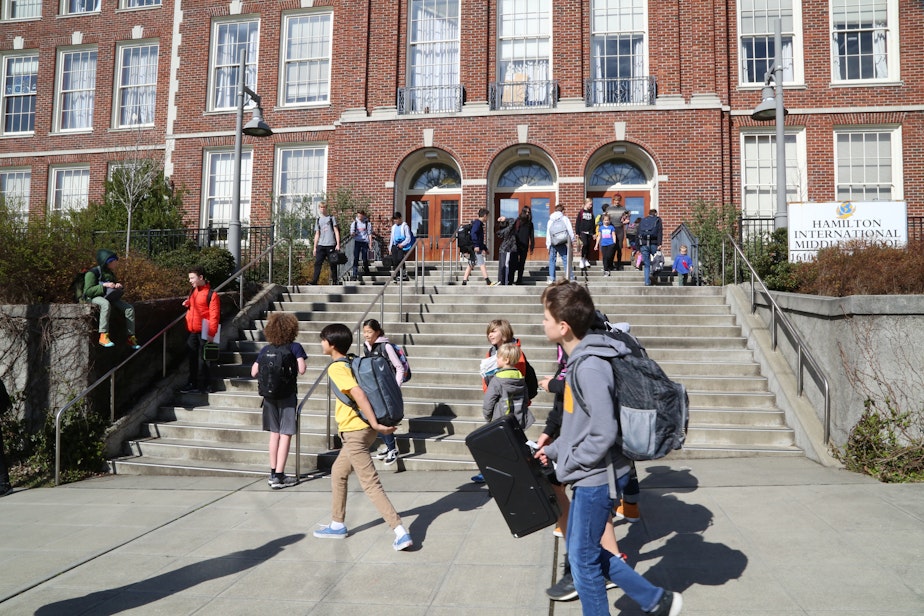New school year amid pandemic: Is Washington state ready to start?

Tens of thousands of students across the state are starting the new school year – and almost all of them will be taking classes remotely, at least for the foreseeable future. But in some smaller and rural districts, schools are going ahead with in-person instruction.
Political analysts C.R. Douglas with Q13 News and Joni Balter of “Civic Cocktail” on the Seattle Channel joined KUOW’s Angela King to discuss.
Angela King: Given that the state is still seeing a relatively high number of new Covid-19 cases every day, why didn't Gov. Jay Inslee just keep the full statewide school closure in place from last spring?
C.R. Douglas: Well, Inslee has definitely been under a lot of pressure to lighten up on all his Covid restrictions. So that's part of it. Also, we're several months into this. Districts have had time to prepare and get creative, unlike in the spring. And the third factor I would say is that while we still have a lot of Covid cases, the new ones are coming down after spiking during the first few months of reopening. So add that all up and the governor felt it was best to issue clear guidelines and recommendations but then let individual districts and school boards make the final decision. And then after all is how our education system typically works: There's a there's a lot of local control built into it.
King: Are school districts ready?
Joni Balter: I interviewed Seattle school superintendent Denise Juneau on Civic Cocktail this week, and my take away: It’s a necessary leap of faith among parents, students, teachers. This fall will certainly be more organized than spring, which did not go well. Teachers are learning to flip their classes to virtual. It's a lot harder than you think. I'm an adjunct professor at Seattle University, and we've been training this summer. It's challenging and we are hoping -- and there's your leap -- we know how to keep students engaged. It's very tough to miss that in-person connection. I worry especially about elementary students sitting in front of computers many hours a day.
Sponsored
King: So technology is a huge part of the equation and we do live in a rather sophisticated tech region.
Balter: Well, that's the good news. Our local tech companies and tech nonprofits are helping -- they are assisting with the need to provide computers and hotspots. Remember, not all families have great Wi-Fi access. And this week, Alaska Airlines stepped in to help transfer 12,000 iPads -- that were stuck in a Boston warehouse -- to Seattle. Now is it really true that Seattle schools have provided computers and hotspots to 53,000 students? And do all of those connections and computers work? We're about to find out.
King: We were talking about some districts reopening while others are being a lot more cautious. A lot of folks just, as we said before, are worried about what's going to happen next.
Douglas: There are a few places opening with full in-person teaching, yes, but it's a very small number, maybe 3,000 to 4000 students, mostly in areas where the Covid rate is low. And you know, they're following mask and social distance protocols and often using alternate days, so not everyone is at school all at once. So it's not like the Wild West out there. What's interesting is that even though Inslee’s remote learning guidelines are voluntary, over 94% of the state’s students are starting school that way. So nearly all districts have landed in the same place as the governor, when it comes to how they're approaching the new school year.
King: You have some schools alternating days -- is that really going to make a difference? When it comes to keeping the virus potential spread down?
Douglas: Well, it's definitely going to help keeping students more spaced out. When you have half the number in a school you have a lot more opportunity to keep them apart. What's clear from all these districts is that they're going to course correct as they go. If cases spike, they'll change their plan. They've all made that pretty clear.
Sponsored
Balter: I was surprised how forthcoming the Seattle superintendent was about the challenges of last spring. But two hopeful ideas she talks about are providing a lot of flexibility to tackle specific problems in individual classrooms and the possibility of outdoor learning at some point. This is on the horizon. I like the idea using a place like T-Mobile Park with that roof that taxpayers paid a bundle for years ago.
Douglas: You know, whatever model schools decide, it's pretty inevitable that the already challenging issue of inequality will get even worse, wealthier families let's face it are better equipped to deal with remote learning. They can hire tutors, they can afford daycare. So unfortunately, we're likely to come out of all this with an even wider achievement gap than we started with.





